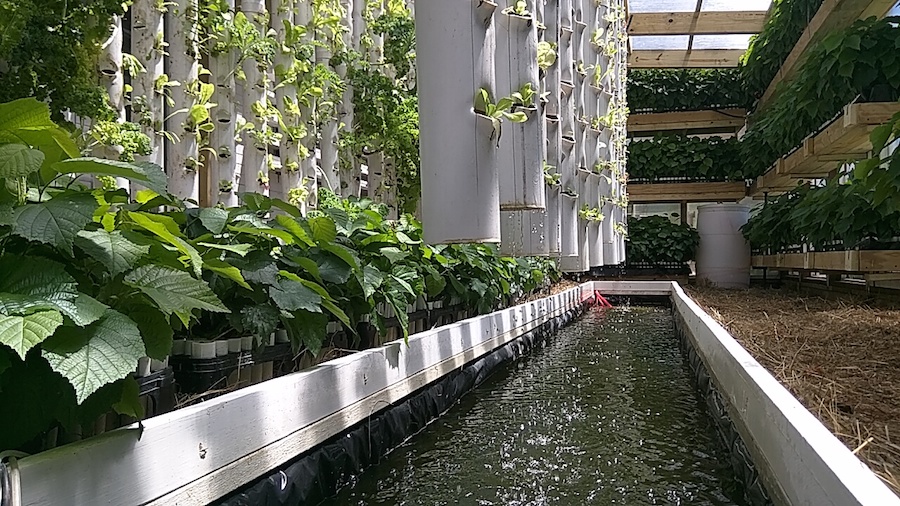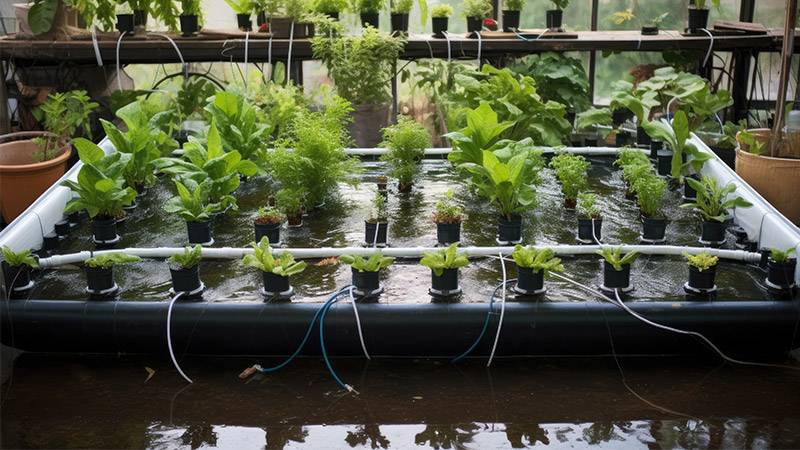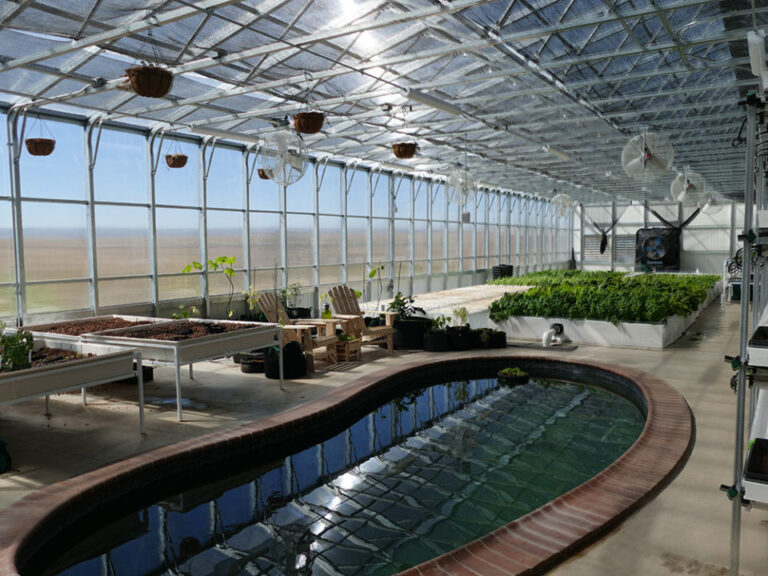In a unique greenhouse with aquaponics, you grow plants and raise Fish together. The fish waste gives food to the plants, and the plants help clean and filter the water for the Fish.
This teamwork helps in eco-friendly farming, saves water, uses space well, and is kind to the environment.
Introduction to Aquaponics in Greenhouse
Aquaponics is a cool way of farming that mixes fish farming (raising Fish) with hydroponics (growing plants without soil).
It’s like creating a teamwork system where fish waste helps plants grow, and the plants keep the water clean for the Fish. It’s like nature’s way of making things work together.
Combining aquaponics with greenhouses is like making farming even smarter and eco-friendly. Greenhouses are like special places where we can control how plants grow. When we team them up with aquaponics, it’s like magic! Here are some awesome things about it:
- Grow Stuff All Year: Greenhouses can make plants grow even when it’s not sunny outside. When we add aquaponics, we can keep producing food all the time, no matter the weather.
- Save Water: Aquaponics uses way less water than regular farming. It’s like recycling water between Fish and plants. Greenhouses make it even better by saving even more water.
- Get More Food: The fish waste helps plants grow super well. Greenhouses make sure plants have the perfect conditions to grow big and give us more food.
- Use Less Electricity: Greenhouses are like using the sun’s power for free. When we do aquaponics in a greenhouse, we don’t need as much electricity. It’s like being smart with energy.
How Aquaponics Works

Teamwork Between Fish and Plants
In aquaponics, Fish and plants team up to create a win-win situation. It’s like having a great partnership where each side helps the other out. Here’s how it works:
- Fish Contribution: Fish do their thing and produce waste. This waste contains nutrients that plants love. It’s like Fish giving a special gift to the plants.
- Plants’ Role: The plants are like superheroes that take the fish waste and turn it into food. They use these nutrients to grow and become strong. They clean the water in the process, making it a comfy home for the Fish.
- The Circle of Goodness: It’s a circle of goodness – Fish give nutrients to plants, plants clean the water for Fish, and the cycle keeps going. It’s a perfect example of teamwork in nature.
Nitrogen Cycle Unveiled
The nitrogen cycle is like aquaponics’s VIP (Very Important Process). It’s how the fish waste turns into plant food without causing any trouble. Let’s break it down:
- Fish Release Ammonia: Fish are cool but release ammonia in their waste. Ammonia isn’t great for Fish in large amounts, but this is where the magic begins.
- Beneficial Bacteria Step In Good bacteria enter the scene. They convert ammonia into nitrites, which is a bit better but still not ideal.
- More Bacterial Action: The story doesn’t end there. More helpful bacteria come in and turn nitrites into nitrates. Nitrates are like the VIP tickets for plants – they love them!
- Plants Feast on Nitrates: Plants are hungry for nitrates and gladly take them from the water. This nourishes the plants and purifies the water, making it a comfy home again for the Fish.
- Cycle Repeats: The cycle keeps repeating – Fish create waste, bacteria transform it, and plants use it. It’s a sustainable loop that keeps everyone happy and healthy.
Understanding the teamwork between Fish and plants and the nitrogen cycle is like knowing the secret recipe for a successful aquaponics system. It’s nature’s way of making sure everyone gets what they need while keeping the environment in harmony.
Components of an Aquaponic Greenhouse
Fish Tanks: Picking the Right Fish Friends
Choosing Fish Wisely: The fish tank is like the bustling neighborhood of your aquaponics system. It’s crucial to pick the right Fish that get along with the plants and thrive in the system.
Common choices include tilapia, trout, or even the colorful and popular koi. Each type has its preferences and perks, so it’s like assembling a fish dream team.
Maintaining Fish Health: Keeping the Fish happy is key. Proper water conditions, feeding schedules, and monitoring of their well-being are like ensuring a harmonious community in the tank.
Grow Beds: Plant Homes in Nutrient-Rich Waters
Planting without Soil: Grow beds are where the plants make their homes. Instead of soil, they’re nestled in beds filled with nutrient-rich water from the fish tanks. It’s like providing a lavish feast for the plants right at their doorstep.
Choosing Plants That Thrive: Picking the right plants is essential. Leafy greens, herbs, and even some fruiting plants do exceptionally well in aquaponic systems. It’s like creating a menu of plant options that will flourish in the water-based environment.
Pumps and Plumbing: The Aquaponic Circulatory System
Water Circulation Magic: Pumps and plumbing are the unsung heroes of the aquaponic greenhouse. They ensure that water moves smoothly between the fish tanks and grow beds. It’s like creating a seamless highway system connecting fish waste to plant nutrition.
Maintaining Flow Balance: Properly sized pumps and well-designed plumbing are crucial. They help maintain a balanced flow, ensuring that fish waste reaches the plants and the purified water goes back to the Fish. It’s like orchestrating a well-choreographed dance between the aquatic and plant elements.
Avoiding Clogs and Hiccups: Regular check-ups on pumps and plumbing are like preventive health measures. By avoiding clogs or hiccups, the entire system runs smoothly, ensuring that Fish and plants get what they need when they need it.
Understanding these components is like knowing the characters in a play – each has a role, and when they work together, the aquaponic greenhouse becomes a thriving stage for Fish and plants alike.
It’s all about creating a balanced and efficient ecosystem where everyone plays their part in the circle of aquaponic life.
Benefits of Aquaponics in Greenhouses
Water Efficiency: Using Water Wisely
Smart Water Usage: Aquaponics in greenhouses is like the superhero of water efficiency. It uses about 90% less water compared to traditional farming. The closed-loop system recycles water between Fish and plants, making sure every drop counts.
Conserving a Precious Resource: With water becoming scarcer, this method is like a water-saving champion. It minimizes wastage and ensures that water is used efficiently, benefitting both the environment and our wallets.
Space Utilization: Going Vertical for More
Stacking the Green Goodness: Greenhouses with aquaponics are masters of space optimization. They allow for vertical farming, like creating plant skyscrapers. It’s like getting the most out of every inch, especially beneficial in urban areas or places with limited farming space.
Maximizing Every Level: Imagine Fish swimming below and plants growing above – it’s like a double-decker farm! This efficient use of space is a game-changer, allowing for more food production in a smaller footprint.
Environmental Impact: Kind to Earth
Reducing Chemical Reliance: Aquaponics in greenhouses is like waving goodbye to over-reliance on chemical fertilizers. The fish waste provides natural nutrients for plants, creating a healthier and more sustainable growing environment.
Minimal Waste, Maximum Benefit: The closed-loop system ensures that nothing goes to waste. It’s like being nature-friendly superheroes, stopping extra nutrients from getting into the water and making sure we don’t harm the nearby environment too much.
A Greener Future: By lowering the environmental footprint, aquaponics in greenhouses is like paving the way for a greener and more sustainable future. It’s a step towards farming practices that nurture the Earth rather than deplete its resources.
In essence, the benefits of aquaponics in greenhouses are like a triple win – saving water, making the most of space, and being kind to the environment. It’s a smart and sustainable approach to farming that showcases the potential of working with nature rather than against it.
Plant and Fish Selection
Recommended Plants for Aquaponics
Leafy Greens: Leafy greens like lettuce, kale, and spinach are aquaponics all-stars. They thrive in the nutrient-rich water, growing fast and healthy. It’s like having a green party in your aquaponic beds.
Herbs: Herbs such as basil, mint, and cilantro love the aquaponic environment. They absorb nutrients from the water, making them flavorful and aromatic. It’s like having a herb garden that practically takes care of itself.
Fruiting Plants: Some fruiting plants, like tomatoes and strawberries, can also flourish in aquaponics. It’s like growing your own mini fruit garden, with the Fish contributing to the tasty harvest.
Root Vegetables: You can grow root vegetables like radishes and carrots in special beds with the right kind of soil. While not as common as leafy greens, it’s like adding a bit of variety to your aquaponic menu.
Popular Fish Species for Greenhouse Systems
Tilapia: Tilapia is a superstar in aquaponics. They grow quickly, tolerate changing water conditions well, and are popular for their hardiness. It’s like having reliable and resilient partners in your aquaponic ecosystem.
Trout: Trout is another excellent fish for aquaponics, especially in cooler environments. They’re known for their delicious taste and adaptability. It’s like having a gourmet addition to your aquaponic fish community.
Koi: Koi Fish are not just pretty to look at; they also work well in aquaponics. While not typically consumed, they add an aesthetic element to your fish tanks. It’s like having living ornaments that contribute to the system.
Catfish: Catfish is a popular choice, especially in warmer climates. They’re hardy, grow well, and are well-suited for aquaponic setups. It’s like having a reliable teammate who can handle some heat.
Goldfish: Goldfish are not just for aquariums; they can also be part of your aquaponic family. While not typically eaten, they contribute to the nutrient cycle. It’s like having a school of colorful collaborators in your fish tank.
Choosing the right combination of plants and Fish is like creating a harmonious ecosystem in your aquaponic greenhouse. It’s about finding partners that thrive together, creating a balanced and productive environment.
Greenhouse Environment Control

Temperature and Humidity Management
Thermostat Wizards: Greenhouses with aquaponics need a bit of temperature magic. Installing thermostats is like having wizards that keep things just right. They control the temperature, ensuring it’s comfy for Fish and plants.
Humidity Harmony: Balancing humidity is like creating the perfect dance floor for plants. Too much or too little can be tricky, but with proper management, it’s like finding the sweet spot that keeps everyone happy and thriving.
Cooling and Heating Tricks: In extreme weather, additional cooling or heating systems come into play. It’s like giving your greenhouse a cozy sweater in winter and a refreshing breeze in the summer. These tricks ensure a stable environment year-round.
Ventilation and Natural Light Considerations
Breath of Fresh Air: Ventilation is like the breath of life for a greenhouse. It ensures a steady exchange of air, preventing stuffiness. It’s like opening windows to let in the fresh breeze, keeping the atmosphere healthy.
Sunshine Power: Greenhouses love natural light, and it’s like the sun is their best friend. Planning the layout to maximize sunlight exposure is crucial. It’s like positioning your greenhouse to soak up the sun’s energy for optimal plant growth.
Shade Strategies: Sometimes, too much sun can be a bit overwhelming. Shade cloths act like sun umbrellas, providing relief when the rays get too intense. It’s like giving your plants sunglasses for those scorching summer days.
Artificial Lighting Backup: For days when the sun takes a break, artificial lighting steps in. It’s like having a backup plan – ensuring that plants still get the light they need to flourish even on cloudy days or during the darker months.
Controlling the environment in an aquaponic greenhouse is like being a master conductor. Balancing temperature, humidity, ventilation, and light orchestrates a symphony where Fish and plants harmonize, creating an ideal habitat for sustainable growth.
Challenges and Solutions
Potential Issues in Aquaponic Greenhouse Systems
Water Quality Hiccups: Sometimes, the water might get a bit out of balance. It’s like a mini-ecosystem, and changes can affect the health of Fish and plants. Issues like pH fluctuations or nutrient imbalances can arise.
Unwanted Pests and Diseases: Just like any garden, aquaponic greenhouses can have unwanted visitors. Pests or diseases might sneak in, impacting the well-being of plants and Fish alike. It’s like dealing with tiny invaders that need to be kept in check.
Equipment Glitches: The pumps, filters, or other equipment may decide to take an unexpected break. It’s like a technological hiccup that can disrupt the smooth flow of your aquaponic system.
Strategies for Troubleshooting and Maintaining System Health
Regular Water Testing: Testing the water is like giving your system a health check. It helps catch any imbalances before they become major issues. Adjusting pH levels or nutrient concentrations ensures a happy aquatic and plant community.
Integrated Pest Management (IPM): Like having a superhero squad for your plants, IPM is a strategic approach. It involves using beneficial insects or organic methods to tackle pests. It’s like creating a natural defense system for your aquaponic team.
Equipment Check-Ups: Regularly inspecting pumps, filters, and other equipment is like giving your system a spa day. Catching potential issues prevents disruptions. It’s like ensuring all the mechanical parts are in harmony.
Diverse Plant and Fish Selection: Diversity is like a secret weapon. Different plants and Fish can support each other and provide resilience against potential issues. It’s like having a variety pack that can adapt to changing conditions.
Education and Monitoring: Knowledge is power. Learning about aquaponics and closely monitoring your system is like being a vigilant guardian. It helps you spot any changes early on and take corrective action before things get out of hand.
Emergency Response Plan: Like having a first aid kit for your system, having a plan in case of emergencies is essential. Knowing what to do if issues arise ensures a swift and effective response. It’s like having a safety net for your aquaponic adventure.
In aquaponic greenhouses, challenges are like puzzles waiting to be solved. With a proactive mindset, regular monitoring, and a toolbox of strategies, you can keep your system running smoothly and enjoy the rewards of a thriving and sustainable ecosystem.
FAQs
What is aquaponics in a greenhouse?
Aquaponics in a greenhouse is a method of farming where plants and Fish are grown together in a closed system.
How does the aquaponics system work in a greenhouse?
Fish waste produces nutrients for plants. As plants absorb these nutrients, they help clean and filter the water, creating a balanced and sustainable ecosystem.
What types of fish are suitable for greenhouse aquaponics?
Common choices include tilapia, trout, and catfish. The best Fish depend on factors like water temperature and the specific needs of the plants being grown.
What plants can be grown in aquaponics systems within greenhouses?
Various plants, such as lettuce, herbs, tomatoes, and peppers, thrive in aquaponic systems. Leafy greens generally do well due to their nutrient requirements.
Is a greenhouse necessary for aquaponics?
While not mandatory, a greenhouse provides a controlled environment, protecting the system from external factors and allowing year-round cultivation.
How often should water parameters be monitored in aquaponics?
Regular monitoring is crucial. Check water pH, ammonia, nitrites, and nitrates at least weekly to ensure a healthy balance for both Fish and plants.
What are the advantages of using aquaponics in a greenhouse?
Benefits include water conservation, efficient space utilization, reduced environmental impact, and a sustainable farming method.
Do I need prior experience to set up an aquaponics system in a greenhouse?
While experience helps, many resources and guides are available for beginners. Starting small and learning as you go is a common approach.
Can I use any type of soil in aquaponics greenhouse systems?
No soil is required; plants grow in a soilless medium like gravel, clay pellets, or coconut coir, receiving nutrients directly from the water.
What do I feed the Fish in an aquaponics system?
Fish can be fed commercial fish food. The type and amount depend on the fish species and their nutritional needs.
How do I prevent and manage pests in aquaponics greenhouses?
Implementing natural pest control methods, such as introducing beneficial insects or maintaining a balanced ecosystem, can help minimize pest issues without the use of chemical pesticides.
Conclusion
In conclusion, aquaponics within greenhouses represents a forward-thinking and sustainable approach to farming.
The synergy between Fish and plants creates a harmonious ecosystem that maximizes resource efficiency, minimizes environmental impact, and offers a reliable source of year-round, high-quality produce.
While challenges may arise, proactive monitoring and thoughtful solutions ensure the continued success of this innovative and eco-friendly farming method.
As we navigate the complexities of modern agriculture, aquaponic greenhouses stand out as a promising solution, embodying a balance between productivity and environmental stewardship.

